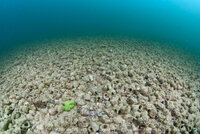Hi all,
The reason that calcium carbonate is such a useful compound for organisms (and has build up into huge biogenic rock layers over the last 3 billion years) is really the equilibria between CO2 ~ HCO3 ~ CaCO3.
The problem for the mollusc shell is that if you add an acid (H+ ion donor), CaCO3 will be converted into ions
This means that the older shell will degrade over time.
The rate of degradation will depend upon the excess of H+ ions, and we can estimate this from the pH (the ratio of H+ ion donors : H+ ion acceptors), the lower the pH ("greater the excess of H+ ion donors") the more quickly the shells will degrade.
If you always have an excess of H+ ion acceptors, ("base-rich" conditions like Lake Tanganyika) the calcium carbonate will never dissolve and huge Neothauma shell beds (below), can develop

<http://seaframes.wordpress.com/2012/07/16/home-shelly-home/>.
The problem for us is if we take a mollusc which has evolved in hard alkaline water and place it in soft water it won't have any of the physiological adaptations to softer water. This is why you get a limited number of slow growing molluscs in acid waters.
cheers Darrel
The calcium is still there, either combined into a (largely) insoluble compound (often CaCO3, but most calcium compounds aren't very soluble) or as an ion (Ca++). The carbon (C) is slightly different, it can be a solid (CaCO3), in solution (HCO3-, 2HCO3) or as a gas (CO2).I understand the chemical reactions one by one but not as a whole picture inside the tank in addition to everything else. Are you saying that when you add CO2 all of the Ca++ are exhausted?
The reason that calcium carbonate is such a useful compound for organisms (and has build up into huge biogenic rock layers over the last 3 billion years) is really the equilibria between CO2 ~ HCO3 ~ CaCO3.
The problem for the mollusc shell is that if you add an acid (H+ ion donor), CaCO3 will be converted into ions
and even when the ions are re-deposited as insoluble CaCO3, they won't be re-deposited in the same place.2 H+(aq) + CaCO3(s) --> Ca++(aq) + H2O(l) + CO2(g)
This means that the older shell will degrade over time.
The rate of degradation will depend upon the excess of H+ ions, and we can estimate this from the pH (the ratio of H+ ion donors : H+ ion acceptors), the lower the pH ("greater the excess of H+ ion donors") the more quickly the shells will degrade.
If you always have an excess of H+ ion acceptors, ("base-rich" conditions like Lake Tanganyika) the calcium carbonate will never dissolve and huge Neothauma shell beds (below), can develop

<http://seaframes.wordpress.com/2012/07/16/home-shelly-home/>.
The problem for us is if we take a mollusc which has evolved in hard alkaline water and place it in soft water it won't have any of the physiological adaptations to softer water. This is why you get a limited number of slow growing molluscs in acid waters.
cheers Darrel



